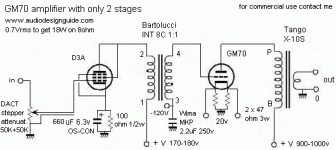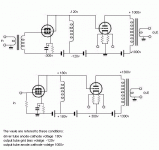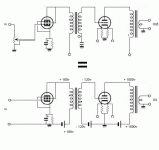As suggested by George in the other forum:
Andrea, you have the irons, you have most of the circuit needs, why don't you try the promising D3a - Gm70 2stage SE solution, D3a can do the trick also with 1:1 interstage...
Regards,
George
I have started the measurements of this configuration using Bartolucci interstage 1:1 48H INT8C and Tango X-10S (soon I will test Bartolucci OPT)
http://www.audiodesignguide.com/Cla..._1000v_Tango_BartolucciNew_freq_8ohm_90mA.gif
Very good frequency band 10Hz at -3db and 22KHz at -1db
http://www.audiodesignguide.com/Cla...0_1000v_Tango_BartolucciNew_max_8ohm_90mA.gif
Power about 16.5W on 8ohm with only an input of 0.7Vrms
Soon complete schematic.
Andrea, you have the irons, you have most of the circuit needs, why don't you try the promising D3a - Gm70 2stage SE solution, D3a can do the trick also with 1:1 interstage...
Regards,
George
I have started the measurements of this configuration using Bartolucci interstage 1:1 48H INT8C and Tango X-10S (soon I will test Bartolucci OPT)
http://www.audiodesignguide.com/Cla..._1000v_Tango_BartolucciNew_freq_8ohm_90mA.gif
Very good frequency band 10Hz at -3db and 22KHz at -1db
http://www.audiodesignguide.com/Cla...0_1000v_Tango_BartolucciNew_max_8ohm_90mA.gif
Power about 16.5W on 8ohm with only an input of 0.7Vrms
Soon complete schematic.
audiodesign said:As suggested by George in the other forum:
Andrea, you have the irons, you have most of the circuit needs, why don't you try the promising D3a - Gm70 2stage SE solution, D3a can do the trick also with 1:1 interstage...
Regards,
George
I have started the measurements of this configuration using Bartolucci interstage 1:1 48H INT8C and Tango X-10S (soon I will test Bartolucci OPT)
http://www.audiodesignguide.com/Cla..._1000v_Tango_BartolucciNew_freq_8ohm_90mA.gif
Very good frequency band 10Hz at -3db and 22KHz at -1db
http://www.audiodesignguide.com/Cla...0_1000v_Tango_BartolucciNew_max_8ohm_90mA.gif
Power about 16.5W on 8ohm with only an input of 0.7Vrms
Soon complete schematic.
Very good results Andrea. I'm glad that worked this way. Looking forward for different OPTs comparison and sonic results also.
Regards,
George
Gluca said:I'd suggest to stack the supplies and direct couple the tubes (getting rid of the interstage). Been there wit GM70, you will be surprised.
Gianluca
Gianluca tell us some more details about your results, measurements, operating points e.t.c
audiodesign said:Today first comparation test with 4 my friends:
---
GM70 graphite give a bad result when compared to copper type.
Then maybe you should do some adjustments...there are no reason that the inferior("copper") tube should do better, just because it's rarer and more expensive...
Arne K
Do you think an amplifier like this will still be worth it on high sensitivity speakers (97db+)? Or is it power vs. quality?
I'm looking for a SET that can do rock, house and heavy orchestra.
What is the difference between your 845 amplifier and this one, instead of saying gm70 is better. Maybe include a 300b to the comparison.
I enjoy your worjk very much and I'm learning alot!
I'm looking for a SET that can do rock, house and heavy orchestra.
What is the difference between your 845 amplifier and this one, instead of saying gm70 is better. Maybe include a 300b to the comparison.
I enjoy your worjk very much and I'm learning alot!
Have a look at these.....
http://www.diyaudio.com/forums/showthread.php?s=&threadid=42259
http://www.dddac.de/op06.htm
http://www.diyaudio.com/forums/showthread.php?s=&threadid=42259
http://www.dddac.de/op06.htm
Gluca said:I'd suggest to stack the supplies and direct couple the tubes (getting rid of the interstage). Been there wit GM70, you will be surprised.
Gianluca
Surprised good or surprised bad?
aroS3 said:
Gianluca tell us some more details about your results, measurements, operating points e.t.c
I just have a Schematic but I could not find any measurement. I guess it was flat as pancake from 20 to 20k looking at the results I had with other tubes in the same amp.
There is no point in using an interstage when you can DC the stages (unless you are driving the power tube into A2 and you need a step-down ratio). You are loading the driver stage with the interstage transfomer's inductance: just get rid of the secondary.
Ciao
Gianluca
serph1nia said:Do you think an amplifier like this will still be worth it on high sensitivity speakers (97db+)? Or is it power vs. quality?
I'm looking for a SET that can do rock, house and heavy orchestra.
What is the difference between your 845 amplifier and this one, instead of saying gm70 is better. Maybe include a 300b to the comparison.
I enjoy your worjk very much and I'm learning alot!
The quality of this amplifiers using 845 or GM70 is very high like my 2A3 PSE considered by me a reference.
In this high voltage amplifier there is more dynamic but without compromise on quality.
I suggest it only to DIY with some experience with previous vacuum tube amplifier because the 1Kv is dangerous.
I don't consider vey well the 300b because this have a strange sound not natural and only some the medium frequency band is good. Il like only these 3 output tubes + SV572-3 and SV811-3 (all tested).
Gluca said:
I just have a Schematic but I could not find any measurement. I guess it was flat as pancake from 20 to 20k looking at the results I had with other tubes in the same amp.
There is no point in using an interstage when you can DC the stages (unless you are driving the power tube into A2 and you need a step-down ratio). You are loading the driver stage with the interstage transfomer's inductance: just get rid of the secondary.
Ciao
Gianluca
Gianluca, have you tested this amplifier ? or do you know someone that have build it ?
I have built and tested it and listened to that amp for a while. Now the same amp with the same irons is running with other tubes.
In a tube amplifier you cannot avoid the OPT unless you go OTL, that's the first transformer; in that amp you can bias the driver tube with a battery on the cathode or a LED so the input transformer is no longer necessary, and that was the 2nd one.
I have been and I am positively impressed with the stacked supplies amp. Again, it will take few steps to raise the driver PSU, add a resistor on top of the drivers choke to drop enough volts to bias the output tube and finally stack the supplies.
A schematic is worth 1000 words. The 9V battery must be on the right side of the 22K resistor, I never fixed the error on the schematic
Tune Rx to bias the power tube. You don't need the input tranny.
Pics and tests of the amp are here
Building an interstage transformer that must handle DC current, a huge signal swings and being high impedance on both the sides is not a trivial task. Only a few are worth the money you spend and they are not cheap: that's why I do prefer to avoid it. Frankly speaking I prefer C coupling to interstages and direct coupling to C.
Ciao
Gianluca
In a tube amplifier you cannot avoid the OPT unless you go OTL, that's the first transformer; in that amp you can bias the driver tube with a battery on the cathode or a LED so the input transformer is no longer necessary, and that was the 2nd one.
I have been and I am positively impressed with the stacked supplies amp. Again, it will take few steps to raise the driver PSU, add a resistor on top of the drivers choke to drop enough volts to bias the output tube and finally stack the supplies.
A schematic is worth 1000 words. The 9V battery must be on the right side of the 22K resistor, I never fixed the error on the schematic
Tune Rx to bias the power tube. You don't need the input tranny.
Pics and tests of the amp are here
Building an interstage transformer that must handle DC current, a huge signal swings and being high impedance on both the sides is not a trivial task. Only a few are worth the money you spend and they are not cheap: that's why I do prefer to avoid it. Frankly speaking I prefer C coupling to interstages and direct coupling to C.
Ciao
Gianluca
Gianluca,
I have analize your schematic and I have made some modifications to increase the value (I think):
1) skip batteries to prevent problems of discharge
1) use normal SE OPT transformer to skip output cap.
3) set to ground input and output to decrement the dangerousness
So here the 2 solutions:
1) using the ground connected on second stage it is necessary an input transformer 1:1
2) using the ground connected on first stage it is necessary an output transformer with a good separation near to 1500V (not all)
The second one should be the best.
I have analize your schematic and I have made some modifications to increase the value (I think):
1) skip batteries to prevent problems of discharge
1) use normal SE OPT transformer to skip output cap.
3) set to ground input and output to decrement the dangerousness
So here the 2 solutions:
1) using the ground connected on second stage it is necessary an input transformer 1:1
2) using the ground connected on first stage it is necessary an output transformer with a good separation near to 1500V (not all)
The second one should be the best.
Attachments
audiodesign said:Gianluca,
I have analize your schematic and I have made some modifications to increase the value (I think):
1) skip batteries to prevent problems of discharge
1) use normal SE OPT transformer to skip output cap.
3) set to ground input and output to decrement the dangerousness
So here the 2 solutions:
1) using the ground connected on second stage it is necessary an input transformer 1:1
2) using the ground connected on first stage it is necessary an output transformer with a good separation near to 1500V (not all)
The second one should be the best.
I've followed both the ways (ie grounding the drivers input or the power stage input) and there is no difference soundwise. For safety reason (ie to have the input transformer at ground) I elected to ground the lower PSU.
You'd better increase the +180V and use a dropping resistor as per my schematic with the 304TL (I refer to Rx). The driver can be biased with a LED or a rechargeable battery to get rid of the RC network.
That's going to be a great amp
OH! The parafeed cap is bypassing the last PSU's cap. In the series feed arrangement you have the PSU in the signal. OK, that's an other story and thread. I see other advantages with the parafeed (and disadvantages too).
CIao
Gianluca
- Status
- This old topic is closed. If you want to reopen this topic, contact a moderator using the "Report Post" button.
- Home
- Amplifiers
- Tubes / Valves
- Hi-end GM70 amplifier with only 2 stages


